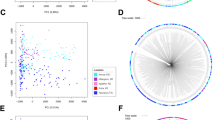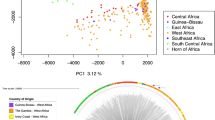Abstract
Infections with the malaria parasite Plasmodium falciparum result in more than 1 million deaths each year worldwide1. Deciphering the evolutionary history and genetic variation of P. falciparum is critical for understanding the evolution of drug resistance, identifying potential vaccine candidates and appreciating the effect of parasite variation on prevalence and severity of malaria in humans. Most studies of natural variation in P. falciparum have been either in depth over small genomic regions (up to the size of a small chromosome2) or genome wide but only at low resolution3. In an effort to complement these studies with genome-wide data, we undertook shotgun sequencing of a Ghanaian clinical isolate (with fivefold coverage), the IT laboratory isolate (with onefold coverage) and the chimpanzee parasite P. reichenowi (with twofold coverage). We compared these sequences with the fully sequenced P. falciparum 3D7 isolate genome4. We describe the most salient features of P. falciparum polymorphism and adaptive evolution with relation to gene function, transcript and protein expression and cellular localization. This analysis uncovers the primary evolutionary changes that have occurred since the P. falciparum–P. reichenowi speciation and changes that are occurring within P. falciparum.
NOTE: In the original version of this paper, the authors failed to acknowledge that sequencing of the P. falciparum IT laboratory isolate was funded by a European Union 6th Framework Program grant to the BioMalPar Consortium (contract number LSHP-LT-2004-503578). This error has been corrected in the PDF version of the article.
This is a preview of subscription content, access via your institution
Access options
Subscribe to this journal
Receive 12 print issues and online access
$209.00 per year
only $17.42 per issue
Buy this article
- Purchase on SpringerLink
- Instant access to full article PDF
Prices may be subject to local taxes which are calculated during checkout



Similar content being viewed by others
Accession codes
Change history
08 February 2007
In the original version of this paper, the authors failed to acknowledge that sequencing of the P. falciparum IT laboratory isolate was funded by a European Union 6th Framework Program grant to the BioMalPar Consortium (contract number LSHP-LT-2004-503578). This error has been corrected in the PDF version of the article.
References
Korenromp, E., Miller, J., Nahlen, B., Wardlaw, T. & Young, M. World Malaria Report 2005 (Roll Back Malaria Partnership, Geneva, 2005).
Mu, J. et al. Chromosome-wide SNPs reveal an ancient origin for Plasmodium falciparum. Nature 418, 323–326 (2002).
Anderson, T.J. Mapping drug resistance genes in Plasmodium falciparum by genome-wide association. Curr. Drug Targets Infect. Disord. 4, 65–78 (2004).
Gardner, M.J. et al. Genome sequence of the human malaria parasite Plasmodium falciparum. Nature 419, 498–511 (2002).
Ning, Z., Cox, A.J. & Mullikin, J.C. SSAHA: a fast search method for large DNA databases. Genome Res. 11, 1725–1729 (2001).
Anderson, T.J. et al. Microsatellite markers reveal a spectrum of population structures in the malaria parasite Plasmodium falciparum. Mol. Biol. Evol. 17, 1467–1482 (2000).
Volkman, S.K. et al. Excess polymorphisms in genes for membrane proteins in Plasmodium falciparum. Science 298, 216–218 (2002).
Carret, C.K. et al. Microarray-based comparative genomic analyses of the human malaria parasite Plasmodium falciparum using Affymetrix arrays. Mol. Biochem. Parasitol. 144, 177–186 (2005).
Yang, Z. & Bielawski, J.P. Statistical methods for detecting molecular adaptation. Trends Ecol. Evol. 15, 496–503 (2000).
McDonald, J.H. & Kreitman, M. Adaptive protein evolution at the Adh locus in Drosophila. Nature 351, 652–654 (1991).
Rocha, E.P. The quest for the universals of protein evolution. Trends Genet. 22, 412–416 (2006).
Florens, L. et al. A proteomic view of the Plasmodium falciparum life cycle. Nature 419, 520–526 (2002).
Le Roch, K.G. et al. Global analysis of transcript and protein levels across the Plasmodium falciparum life cycle. Genome Res. 14, 2308–2318 (2004).
Bozdech, Z. et al. The transcriptome of the intraerythrocytic developmental cycle of Plasmodium falciparum. PLoS Biol. 1, E5 (2003).
Ashburner, M. et al. Gene ontology: tool for the unification of biology. The Gene Ontology Consortium. Nat. Genet. 25, 25–29 (2000).
Marti, M., Good, R.T., Rug, M., Knuepfer, E. & Cowman, A.F. Targeting malaria virulence and remodeling proteins to the host erythrocyte. Science 306, 1930–1933 (2004).
Hall, N. et al. A comprehensive survey of the Plasmodium life cycle by genomic, transcriptomic, and proteomic analyses. Science 307, 82–86 (2005).
Nielsen, R. et al. A scan for positively selected genes in the genomes of humans and chimpanzees. PLoS Biol. 3, e170 (2005).
Garnham, P.C.C. & Duggan, A.J. Malaria Parasites and Other Haemosporidia (Blackwell Scientific, Oxford, 1996).
Martin, M.J., Rayner, J.C., Gagneux, P., Barnwell, J.W. & Varki, A. Evolution of human-chimpanzee differences in malaria susceptibility: relationship to human genetic loss of N-glycolylneuraminic acid. Proc. Natl. Acad. Sci. USA 102, 12819–12824 (2005).
Winter, G. et al. SURFIN is a polymorphic antigen expressed on Plasmodium falciparum merozoites and infected erythrocytes. J. Exp. Med. 201, 1853–1863 (2005).
Li, F. et al. Plasmodium ookinete-secreted proteins secreted through a common micronemal pathway are targets of blocking malaria transmission. J. Biol. Chem. 279, 26635–26644 (2004).
Mu, J. et al. Genome-wide variation and identification of vaccine targets in the Plasmodium falciparum genome. Nat. Genet. advance online publication 10 December 2006 (doi:10.1038/ng1924).
Volkman, S.K. et al. A genome-wide map of diversity in Plasmodium falciparum. Nat. Genet. advance online publication 10 December 2006 (doi:10.1038/ng1930).
Horrocks, P., Kyes, S., Pinches, R., Christodoulou, Z. & Newbold, C. Transcription of subtelomerically located var gene variant in Plasmodium falciparum appears to require the truncation of an adjacent var gene. Mol. Biochem. Parasitol. 134, 193–199 (2004).
Bowman, S. et al. The complete nucleotide sequence of chromosome 3 of Plasmodium falciparum. Nature 400, 532–538 (1999).
Altshuler, D. et al. An SNP map of the human genome generated by reduced representation shotgun sequencing. Nature 407, 513–516 (2000).
Yang, Z. PAML: a program package for phylogenetic analysis by maximum likelihood. Comput. Appl. Biosci. 13, 555–556 (1997).
Rand, D.M. & Kann, L.M. Excess amino acid polymorphism in mitochondrial DNA: contrasts among genes from Drosophila, mice, and humans. Mol. Biol. Evol. 13, 735–748 (1996).
Young, J.A. et al. The Plasmodium falciparum sexual development transcriptome: a microarray analysis using ontology-based pattern identification. Mol. Biochem. Parasitol. 143, 67–79 (2005).
Acknowledgements
We thank the Pathogen Sequencing teams for producing the sequence data used in this study, P. Horrocks and B. Pinches for the supply of DNA from the IT isolate and M. Marti for the list of PEXEL motif–containing genes. This study was funded by the Wellcome Trust through its support of the Pathogen Sequencing Unit and E.T.D.'s group at the Wellcome Trust Sanger Institute.
Author information
Authors and Affiliations
Contributions
D.J. processed SSAHA data, produced diversity and evolutionary measures, analyzed the data and wrote the manuscript. E.T.D. and M.B. directed the project and assisted with analysis of the data and writing of the manuscript. A.P. and A.B. assisted with analysis and processing of the data and biological interpretation of the data. A.T. collected the P. reichenowi sample and extracted DNA. K.S. assisted with data processing and analysis. A.C. provided SSAHA mapping. J.S. assisted with data processing. C.I. resequenced genes and manually verified SNPs. A.-C.U. assisted with parasite DNA extraction. S. Krishna assisted in biological interpretation of the data and parasitology. C.N. shaped some of the initial ideas for the project, assisted in biological interpretation of the data and assisted with parasite DNA extraction. S. Kyes grew the IT parasite and purified and extracted DNA from parasites.
Corresponding authors
Ethics declarations
Competing interests
The authors declare no competing financial interests.
Supplementary information
Supplementary Fig. 1
The distributions of dN/dS estimates are negatively skewed. (PDF 138 kb)
Supplementary Fig. 2
Correlations of dN/dS and expression level are robust to the use of different expression data and to subsets of variation data called using SSAHA. (PDF 415 kb)
Supplementary Fig. 3
Consistent relative differences in evolutionary rates between stage-specific genes were observed with protein and microarray data. (PDF 161 kb)
Rights and permissions
About this article
Cite this article
Jeffares, D., Pain, A., Berry, A. et al. Genome variation and evolution of the malaria parasite Plasmodium falciparum. Nat Genet 39, 120–125 (2007). https://doi.org/10.1038/ng1931
Received:
Accepted:
Published:
Issue Date:
DOI: https://doi.org/10.1038/ng1931



